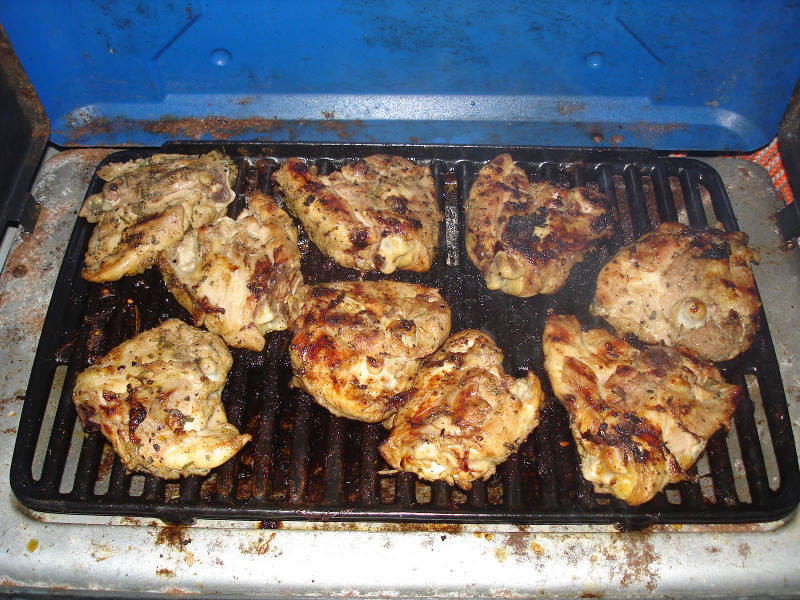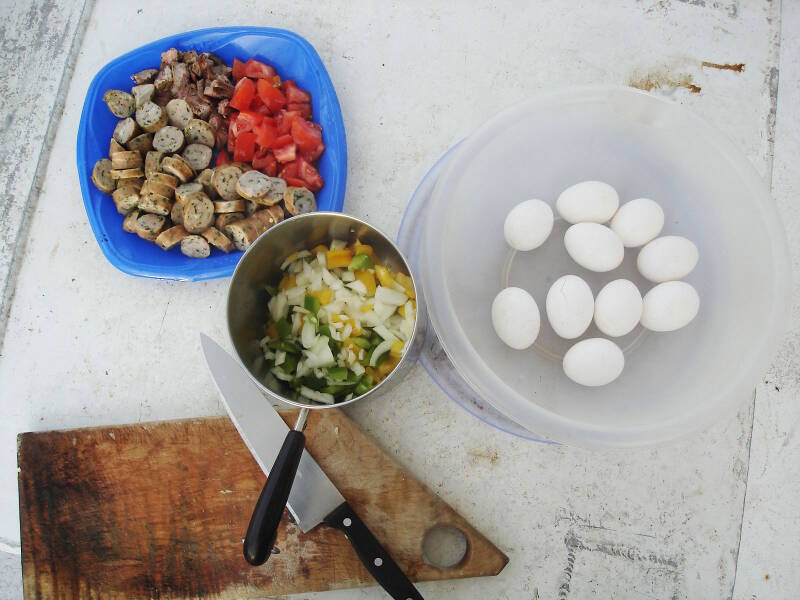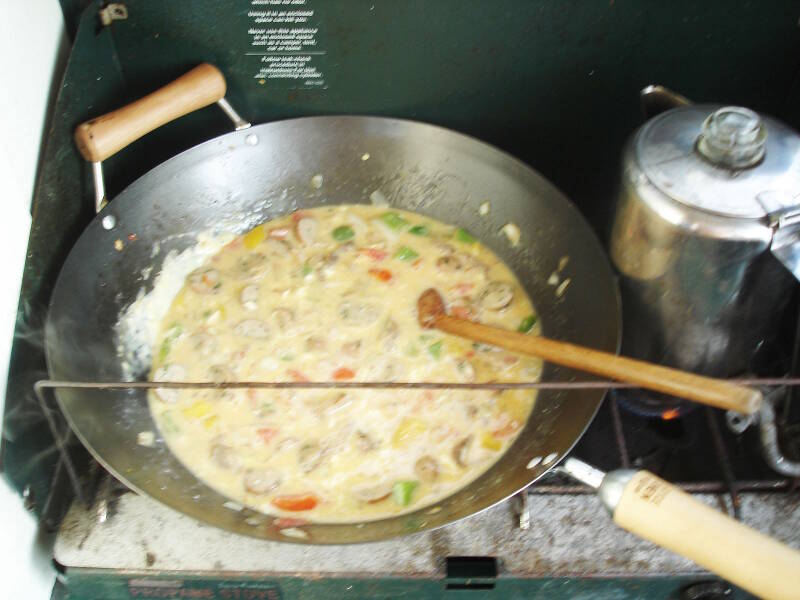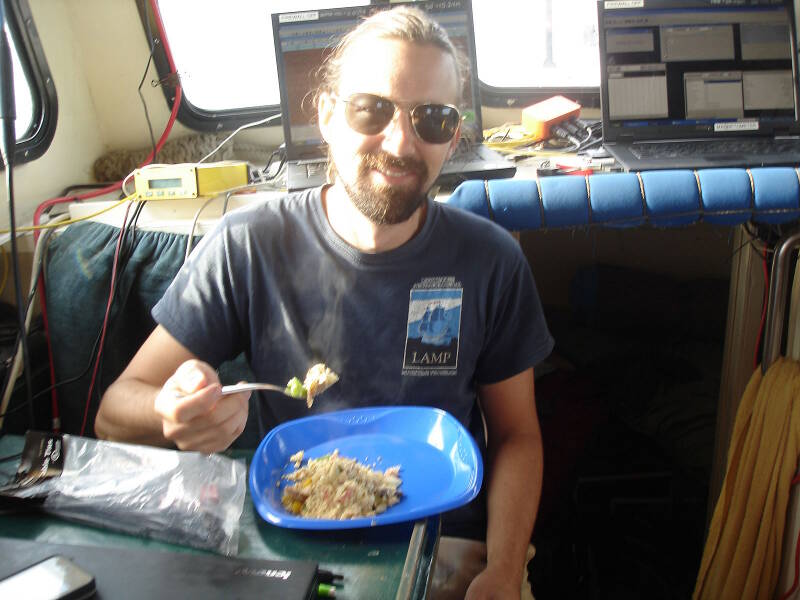
By Chuck Meide, Director of the Lighthouse Archaeological Maritime Program - Lighthouse Archaeological Maritime Program
July 17, 2014

Last night’s dinner: marinated chicken thighs on the camp grill. Image courtesy of Image courtesy of the Search for the Lost French Fleet of 1565 Expedition, NOAA-OER/St. Augustine Lighthouse & Museum. Download larger version (jpg, 586 KB).
On any research project, the way to keep your crew happy and hardworking is through their stomachs. A hungry crew is a grumbling crew, and one that might get downright mutinous at sea. Since I always ask a lot of my team, and push them hard to get the data we seek, I always try to make sure that we have plenty of food on any project I’m running and that everyone gets plenty of home-cooked meals.
That can be somewhat of a challenge on a small research vessel that is cramped with four scientists staying overnight. It takes constant management to ensure that all the needed food gets packed, that the coolers have plenty of ice, and that ice is going from the storage cooler into the food and water coolers as needed. It helps that the boat has a refrigerator, though it is a small one. We have two primary cooking surfaces, a camp stove and a camp grill, along with a second grill as a backup (“two is one, one is none...”). We also have two bottles of propane on board, which always entail attention for safety purposes.
On a large, liveaboard research vessel operated by a university or government entity, there is usually a full-time crew who handles vessel operation with a cook to prepare meals for the crew and working scientists. But on the Roper, the scientists act as the crew and we have to do the cooking as well.

The prepared ingredients for today’s breakfast, “Slophole,” a Roper tradition. A crew’s gotta eat! Image courtesy of Image courtesy of the Search for the Lost French Fleet of 1565 Expedition, NOAA-OER/St. Augustine Lighthouse & Museum. Download larger version (jpg, 320 KB).
Because I enjoy cooking for folks, I tend to cook a lot of the meals on board. This morning I made my Roper breakfast special. We call it “Slophole,” which is named after a term used by Northeast Florida shrimpers to denote a particular spot at sea where a depression on the seafloor has filled with mud which attracts shrimp.
As you can imagine, the Slophole breakfast is somewhat of a mess. Since it is a Lighthouse Archaeological Maritime Program tradition on Roper research cruises, I thought I’d share the recipe here. Now, you should understand the recipe changes each time, depending on what leftovers are available or what fresh food is still uneaten or easy to reach in the cooler.
So this is the recipe that we used today:

All of the ingredients for this morning’s breakfast in the wok on the cabin’s stove. Image courtesy of Image courtesy of the Search for the Lost French Fleet of 1565 Expedition, NOAA-OER/St. Augustine Lighthouse & Museum. Download larger version (jpg, 274 KB).
Chop all the vegetables and set aside. Cut the meat into bite-sized pieces and set aside, keeping the bacon seperate. Break the eggs into a big bowl and whisk with a little milk. It's perfect if the seas are beamy, as they are this morning, since the rocking boat will keep the eggs nice and mixed.

Breakfast is a hit with Brian! We take shifts driving the boat so that we can prepare and eat meals while still gathering data. By the end of the day we finished 10 lanes, or 50 nautical miles of survey. Image courtesy of Image courtesy of the Search for the Lost French Fleet of 1565 Expedition, NOAA-OER/St. Augustine Lighthouse & Museum. Download larger version (jpg, 282 KB).
Throw the bacon onto the ship’s wok and let them sizzle. When there is plenty of bacon grease throw in the veggies and sauté. Onions and peppers go in first, then the tomatoes.
Season with garlic powder, fresh ground pepper, and Adobo. Throw in the sausage and steak (these were already cooked so they are just being re-heated). Finally, pour in the whisked eggs and stir constantly until the eggs are as you like them (I tend to like mine a little wet).
It’s a bit tricky if the wok is sliding back and forth on the stove in beam seas, but you’ll get used to it. If you are boiling coffee at the same time, make sure the coffee pot is shackled to the stove so it won’t tip over.
While slopping the eggs in the wok, add some fresh ground sea salt to the mix and a little more pepper.
Serve up on plastic plates. Trust me, your crew will love it!